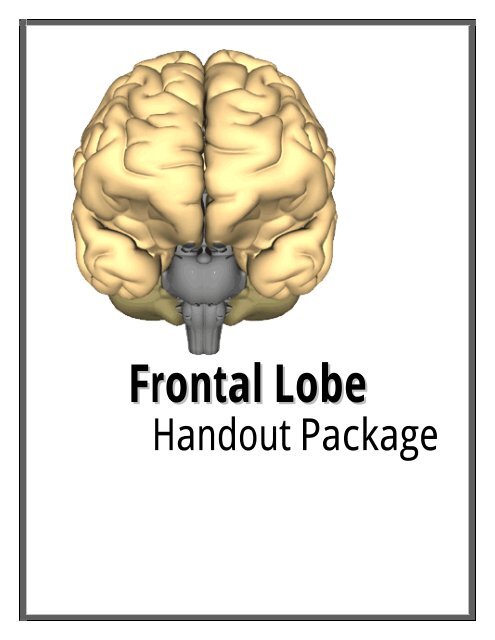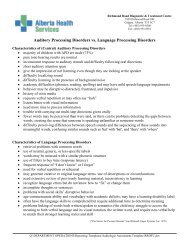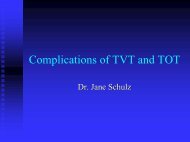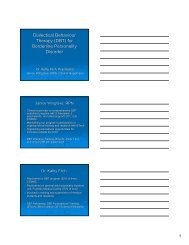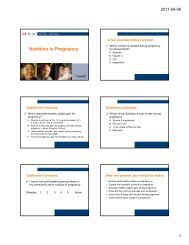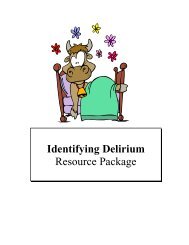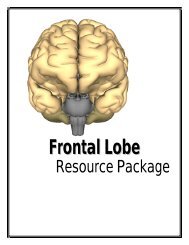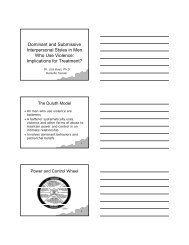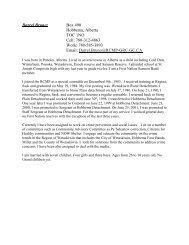Frontal Lobe Function - Onehealth.ca
Frontal Lobe Function - Onehealth.ca
Frontal Lobe Function - Onehealth.ca
Create successful ePaper yourself
Turn your PDF publications into a flip-book with our unique Google optimized e-Paper software.
<strong>Frontal</strong> <strong>Lobe</strong>Handout Package
<strong>Frontal</strong> <strong>Lobe</strong><strong>Function</strong>Learning Objectives1. Explain the basic anatomy andfunctions of the frontal lobe.2. Describe clini<strong>ca</strong>l signs of frontallobe damage and areas of frontallobe deficit.3. Identify therapeutic interventionsincluding compensatory andcognitive rehabilitation strategies.4. Be aware of assessment tools toidentify frontal lobe deficits.<strong>Lobe</strong>s of theCerebrumLimbic <strong>Lobe</strong><strong>Frontal</strong> <strong>Lobe</strong>Parietal <strong>Lobe</strong>Temporal <strong>Lobe</strong>Occipital <strong>Lobe</strong>1
HeLoHeLoHeLo<strong>Frontal</strong> <strong>Lobe</strong>Lies at the front ofthe cerebral cortexContains the main areas ofmotor controlMain Areas of Motor ControlHiHeLoHeLo HeHLoeLoHeLo HeLoHeLoPrimary motor Hellocortex Primary Motor CortexhiTherePremotor CortexHello there(Schwerin, 2006)Main Areas of Motor ControlBro<strong>ca</strong>’s Area(Chudler, 2006)2
Main Areas of Motor ControlPrefrontal Cortex<strong>Frontal</strong> <strong>Lobe</strong>http://www.brainexplorer.org<strong>Function</strong>s of the<strong>Frontal</strong> <strong>Lobe</strong>Learning new tasksAbstract thinkingInhibition and impulsecontrolGoal-directed behaviourPlanningPersonalityClini<strong>ca</strong>l Signs of<strong>Frontal</strong> <strong>Lobe</strong> DamageDisinhibitionApatheticMedial frontal syndromeBehavioural changesMemory impairmentAttention deficitConcrete thinkingPerseveration3
Associated DiagnosesStrokeTumorEpilepsySchizophreniaDementiaOther DegenerativeDiseasesAssociated DiagnosesMultiple SclerosisSubstance-InducedHypoxiaToxic SubstancesInfectionTraumatic Brain InjuryCoupContrecoupPrimaryImpactSecondaryImpact4
<strong>Frontal</strong> vs. Alzheimer DementiaFTDReduced speech outputGood comprehensionPersonality changes earlyPreserved spatialorientationMemory loss variableApraxia uncommonPossible motor signsADFluent aphasiaReduced comprehensionPersonality changes lateImpaired spatialorientationMemory loss earlyApraxia commonMotor signs uncommonearly<strong>Frontal</strong> <strong>Lobe</strong>AssessmentStandardizedAssessment ToolsExecutive Interview(Exit)<strong>Frontal</strong> AssessmentBattery (FAB)5
Executive Interview(EXIT)25-item screen to detect possiblefrontal lobe dysfunctionHelps predict:Executive cognitive functionBehaviour <strong>ca</strong>used by executiveimpairmentCare strategies to preventproblem behaviours<strong>Frontal</strong> AssessmentBattery (FAB)A short bedside cognitive andbehavioural battery to assessfrontal lobe functionsComprised of 6 subtests:ConceptualizationMental flexibilityMotor programmingSensitivity to interferenceInhibitory control testEnvironmental autonomyAdditional CognitiveDeficitsAphasiaPraxisNeglectAnosognosiaJudgment, insight, andsocial appropriateness6
Additional CognitiveDeficitsMemory deficitsLack of originality,inattentiveness, andinappropriate emotionalreactions<strong>Frontal</strong> releaseresponsesInterventions1. Activity-Based2. Compensatory Strategies3. Cognitive Rehabilitation1. Activity-BasedInterventionsLeisure ActivitiesMulti-Sensory InterventionsRole RenewalExerciseCrafts7


